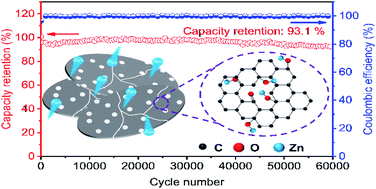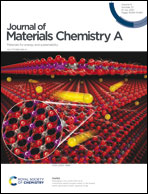Coupling of EDLC and the reversible redox reaction: oxygen functionalized porous carbon nanosheets for zinc-ion hybrid supercapacitors†
Abstract
Zinc-ion hybrid supercapacitors (ZHSCs) are promising next-generation energy storage devices owing to their merits of inexpensiveness, high energy density, high safety, and a long cycle lifespan. However, ZHSC device performance is still unsatisfactory because the carbon cathodes fail to match the high theoretical capacity of Zn electrodes. Herein, oxygen functionalized hierarchical porous carbon (HPC) materials are constructed by an in situ self-activation strategy for enhancing the performance of ZHSCs. Remarkable capacity and energy density are obtained benefitting from the synergistic effect of the electric double-layer capacitance of porous carbon and attractive pseudocapacitance from reversible transformation of oxygen functional groups during charge/discharge processes. Consequently, the as-fabricated ZHSCs demonstrate a high specific capacity of 169.4 mA h g−1, a maximum energy density of 125.1 W h kg−1 at 0.1 A g−1, and an ultrahigh power density of 16.1 kW kg−1. Furthermore, the ZHSCs exhibit an ultralong cycle lifespan of 60 000 cycles at 10 A g−1 and a high-capacity retention of 93.1%. Meanwhile, the corresponding quasi-solid ZHSC device also shows remarkable rate performance and cycling stability. This work provides novel design tactics to enhance the zinc ion storage properties of porous carbon by combining fast ion adsorption and the reversible redox reaction of oxygen functional groups.



 Please wait while we load your content...
Please wait while we load your content...